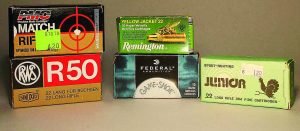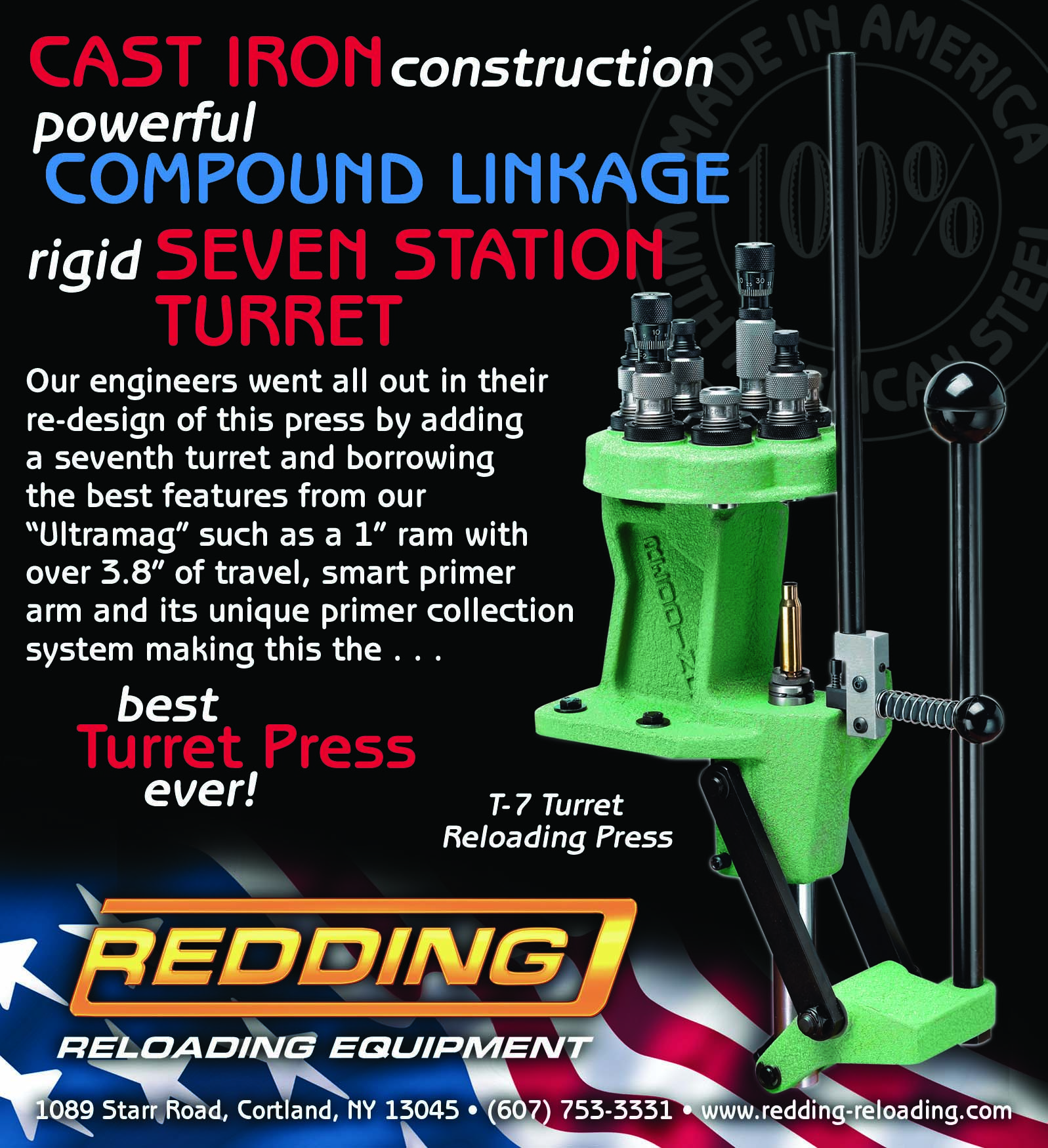by Art Merrill | Contributing Editor

Representatives across the .22LR spectrum: match, hunting and cheap plinker ammo. Note the “expensive” price tag on the pre-shortage match ammo; we’re lucky to find that on today’s plinker stuff.
Some time back I showed you how to reload .22 Long Rifle rimfire ammunition. This year we’ll do one better and reload .22 Magnum. Did you know that .22 WMR bullet diameter is the same as the .223 Remington? But first, let’s see why we would even bother considering it.
We’ve been experiencing a nearly decade-long .22 rimfire shortage and hoarding event. Manufacturers understandably play their cards close to their chests and are a bit reticent on the subject other than to say they are increasing production to meet demand for .22 rimfire ammo. But why did they fall behind demand to begin with? Though conspiracy theories are more fun, we can ascribe rather pedestrian capitalist explanations to the shortage. The speculations and observations here point mostly at the industry, but we shooters also bear some responsibility.
Wars need ammo
Note first that there was a severe non-availability of rimfire ammunition during WWII and another shortage during the Korean conflict. US military weapons have voracious appetites, and few would argue the need to prioritize feeding them over the civilian desire for recreational ammo. The same metals that go into small arms ammunition also go into making other munitions, from Claymores to canon shells, and fighting two protracted Mideast wars puts a strain on the availability of those raw materials.
When you only have X amount of manufacturing space, machinery, employees and raw materials (more on that, below) for making cartridges, are you going to make those that earn you more money (centerfires) or less (.22 rimfire)? And are you going to favor solid government sales contracts or prefer the risk of open markets?
Newbies
Because there is political strength in numbers (and an expanded consumer base), there’s been a concerted industry effort the past decade encouraging gunowners to bring new shooters into the fold. It’s apparently working, as the National Shooting Sports Foundation reports a significant increase in new shooters, many of them women and youth. What cartridge do we start new shooters on — 460 Weatherby? No, we start them on the mild and recoilless .22 rimfire. Adding more .22 shooters without increasing the production of .22 ammunition logically results in a net deficit of ammo, of course. While this specific impact may be small (or it may actually be large), it is still a brick in the load.
Hoarding
Bricks of .22 ammo are more significant bricks in the load, and we can point to shooters’ behaviors as a major factor in their shortage of availability. You know who I’m talking about: the guy who brags that when bricks showed up at UberMart he immediately bought the store limit then called his wife and friends to come buy him some more. On the other side we’ve had gun show scalpers demanding – and getting – $70 for a brick. Sometimes the UberMart buyer and the scalper was the same guy.
Bricks of .22 are finally reappearing on store shelves, but at around $40 each they’re going for roughly twice the pre-shortage price. The just-desserts irony for the hoarders who contributed to the shortage is that the hoarder has bricks for which he’s paid perhaps $70 each, and now they’re worth only half that.
Commodity pricing
Producing ammunition, including .22 rimfire, is subject to commodity pricing. That means the cost of production increases with the rising cost of raw materials – in this case, the cost of metals like lead, copper, zinc and others found in ammunition. When those prices rise, continued profitable production requires an assured market plus passing those price increases along to the consumer.
Recall that the cost of metals did quickly rise about 10 years ago, much of that attributed to the sudden demand from Communist China. Soon thereafter, we began seeing shortages in the most popular recreational cartridges. At that time of falling availability of and increased prices for metals, ammo makers had to consider whether and with which cartridges they could still turn a profit.
Profit focus
Rimfire ammo has never been a significant focus of major American ammo makers. That’s easy to understand when you compare the cost of a single .22 Long Rifle cartridge to that of any centerfire cartridge – there’s more money to be made in the latter. One fairly recent marketing event bears this out: the industry focus on “premium” centerfire ammunition, which began at about the same time as the price increase in metals. One way to stay ahead of the cost/profit curve is to justify a cost increase by improving the quality (or perception of the quality) of a product.
There’s pricey target grade stuff appealing to a niche market of competitive shooters, but there is and has been no premium .22 Long Rifle hunting ammo. The only thing close to “premium” rimfire hunting ammo from a marketing/profit standpoint has been the .22 Magnum.
New stuff
Makers are constantly introducing new cartridges, not because the new ones are light years ahead of the old ones, but because introducing new products is the “grow or die” paradigm of American industry. New cartridges need new rifles chambered for them, a related large profit avenue. For handloaders, new bullets and smokeless powders also come out as technology improves.
The industry’s need to bring out new cartridges has continued even in the face of commodity shortages and escalating prices. With all those market pressures something had to give, and what apparently gave was sensible from a business perspective: reduce the production of or ignore the increasing demand for less profitable cartridges like .22 rimfire. Exacerbating that solution is probably the single largest brick in our .22 shortage load, the introduction of new .17 rimfires.
Many shooters never noticed that the .22 rimfire drought coincided with the introduction of .17 caliber rimfire ammunition and guns. Today gun shop shelves have plenty of .17 HMR, .17 WSM and even .17 MACH IV, but most have no or little .22LR. In this there has been a kind of marketing conspiracy with unintended consequences. Here, the “conspiracy” was to focus on marketing the new .17 rimfire ammo and guns because makers had sunk huge money into development and manufacture of the firearms and cartridges. One way to ensure a profitable return on the financial risk of introducing new .17 rimfire guns and ammo to a historically fickle market is to increase the availability of the .17s while lessening availability of .22 rimfire ammunition (or simply permit it to lessen), essentially driving rimfire shooters into the arms of the .17s.
Rimfire redux
These industry factors – commodity pricing, marketing focus, government contracts, introduction of new premium cartridges and introduction of the .17 rimfires – combined with consumer behaviors – widespread hoarding practices and more new shooters increasing demand – are possibly the “perfect storm” that created the shortage in .22 rimfire ammunition.
Again, just speculation, but more reasonable than Obama sending .22 ammo into the Bermuda Triangle for Elvis to give to the Border Patrol for range practice. Regardless, we don’t have to do without, and that brings us back around to handloading (this is, after all, a handloading column) our own rimfire ammo.




